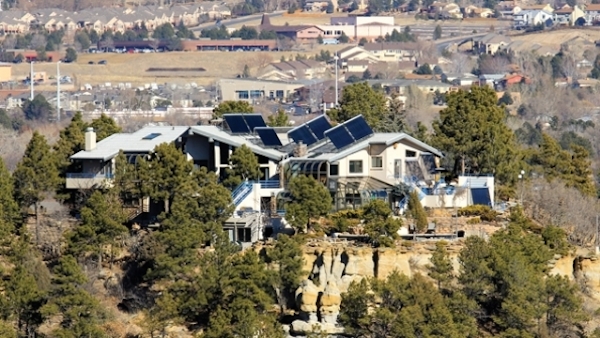
Ray Armstrong’s mountain home in Colorado Springs is a sprawling 5,500 square foot structure, with the living space extending outdoors where the owner’s fish ponds and water gardens are located. Armstrong is an award-winning koi fish enthusiast, and his home uses even more energy since the ponds and tanks, where his fish are, require precise temperature and water regulation. Since such a large home also consumes vast amounts of energy, Armstrong enlisted the help of David Bednarski, owner of Bestway Mechanical in Colorado Springs, to help him install the necessary solar and other technologies to reduce this footprint.
The home is comprised of a lower level and a ground floor. Bednarski commenced his work by first removing the existing forced-air heating system and replacing it with a radiant heating system. The house has a mechanical system that is completely integrated, which means that it heats as well as controls the temperature in all of the 12 indoor zones of the home, as well as the 7 outdoor zones comprised of the ponds, gardens, hot tub and koi fish tanks.
The first stage heating of all the 19 zones and the needed domestic hot water is provided by 10 Apricus AP-30 evacuated tube solar thermal collectors. Seven of these are roof-mounted, while three are wall-mounted. The system also includes a 659-gallon solar storage tank.
For second-stage heating, Bednarski installed a HTP Versa Hydro, which is a 199,000 Btuh high-efficiency boiler that includes a 119-gallon solar heat exchanging storage tank. Once the Versa Hydro senses that solar energy is running low, it slowly starts burning gas to supply the needed energy. According to Bednarski the Versa has, so far, only fired up on low-fire for a few hours during very cold days or overnight. Emergency, third stage heating is provided via a Munchkin MC99, high-efficiency wall-hung boiler, though this one has not yet been needed.
All told, the solar PV array is able to handle 75% of the energy load of the home and the garden. Since the home’s driveway goes uphill, Bednarski installed an 11.5kW SunPower, dual-axis solar PV electric system with onsite and remote Web monitoring capabilities. The dual-axis solar trackers swivel and rotate up and down and from east to west. According to Bednarski, this setup provides 35% to 40% more energy as would be provided by stationary solar panels.
Still in the works is finding a way to decrease the remaining 25% of the energy load of the home. The team is considering installing LED lighting, upgrading the pumps, power factor adjustments, and so on. As for the mechanical system, it now has temporary Caleffi and Taco controls in place, while they plan to install a more permanent Rehau Smart Controls system soon.
Related Articles on JetsonGreen.com:
Energy Efficiency is Critical in Home Design
A Zero Net Energy Prototype House Built in California
A New Water Heater Cuts Energy Use by Nearly Half

Leave a Reply
You must be logged in to post a comment.